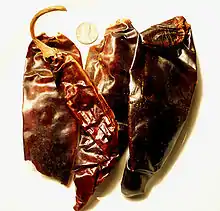Guajillo chili
A guajillo chili or guajillo chile (chile guajillo in Spanish, meaning big pod) is the dried form of mirasol chili, a landrace variety of chile pepper of the species Capsicum annuum, and is the second-most commonly used dried chili in Mexican cuisine after poblanos (ancho).[1][2][3] The Mexican state of Zacatecas is one of the main producers of guajillo chilies. There are two main varieties that are distinguished by their size and heat factors. The guajillo puya is the smaller and hotter of the two (puyar, in Spanish, is to prick or poke). In contrast, the longer and wider guajillo has a more pronounced, richer flavor and is somewhat less spicy.
| Guajillo chili | |
|---|---|
 Several dried guajillo chiles | |
| Species | Capsicum annuum |
| Origin | Mexico |
| Heat | |
| Scoville scale | 2,500–5,000 SHU |
Its heat (rating 2,500 to 5,000 on the Scoville scale) is considered mild to medium.[1] Guajillo chilies have many applications and are used in a variety of Mexican preparations. For instance, they are sometimes used to make a salsa for tamales; the dried fruits (chilies) are seeded, soaked or simmered, then pulverized or mashed/pureed into a paste, then cooked with several other ingredients to produce a flavorful sauce.
Guajillo chilies are used in marinades, salsas, pastes, butters or adobos (spice rubs) to flavor meats and fat or oil with other ingredients. The guajillo chili, with its leaner flavor profile, is used with fish and chicken, or added to salsa as a side dish. Guajillo chilies are also used in a Salvadoran spice mix called Relajo. In El Salvador, guajillo chilies are known as chile guaco.
Some Mexican dishes where chile guajillo is a main ingredient are:
- Chilate or mole de olla
- Pambazos
- Consomés
- Carne adobada
See also
- Chipotle - The smoked and dried form of the jalapeño chili pepper.
- Pasilla - The dried form of the chilaca chili pepper.
- List of smoked foods
References
- Bray, Matt (22 November 2014). "Guajillo pepper: The sweet side of spice". Retrieved 4 September 2018.
- "Guajillo Peppers". WorldCrops for Northern United States. Retrieved 16 November 2018.
- Kraft, K. H.; Brown, C. H.; Nabhan, G. P.; Luedeling, E.; Luna Ruiz, J. d. J.; Coppens d'Eeckenbrugge, G.; Hijmans, R. J.; Gepts, P. (21 April 2014). "Multiple lines of evidence for the origin of domesticated chili pepper, Capsicum annuum, in Mexico". Proceedings of the National Academy of Sciences. 111 (17): 6165–6170. Bibcode:2014PNAS..111.6165K. doi:10.1073/pnas.1308933111. PMC 4035960. PMID 24753581.